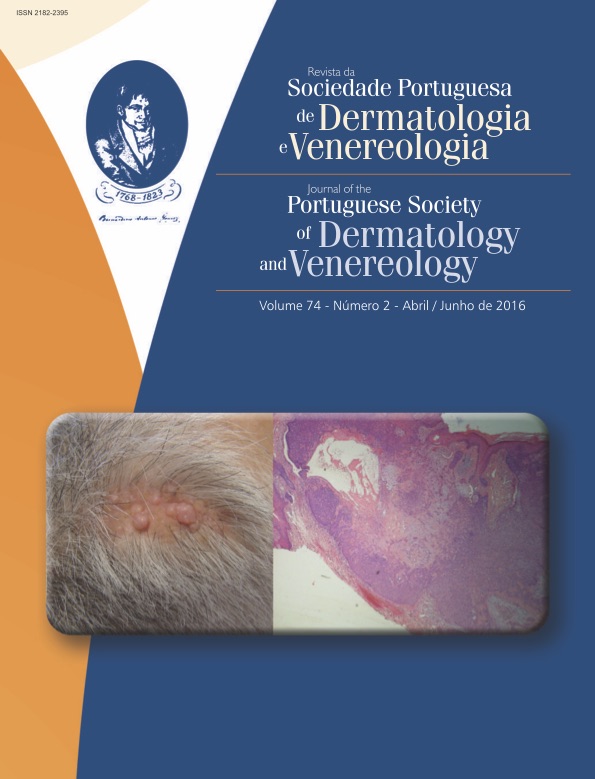Sirolimus and Primary Prevention of Non-melanoma Skin Cancer in Kidney Transplant Recipients – A Retrospective Study
Abstract
Introduction: Immunosuppression plays a central role in the pathogenesis of skin cancer in kidney transplant recipients. Recently, the potential for sirolimus to reduce the incidence of non-melanoma skin cancer in this population has been studied.
Objective: To analyse the relationship between initial maintenance immunosuppressive regimens and the onset of non-melanoma skin cancer – squamous cell carcinoma and basal cell carcinoma – in kidney transplant recipients.
Methods: Retrospective analysis of clinical records belonging to patients submitted to kidney transplantation between years 2002 and 2012, which were subsequently evaluated for the first time, in our Dermatology Department. Kidney transplant recipients were divided in three groups according to the initial maintenance immunosuppressive regimen: group A (sirolimus-based), group B (tacrolimus-based) and group C (cyclosporine-based).
Results: Of the 188 patients studied 24.5% (n=46) were diagnosed with 83 non-melanoma skin cancer (42 basal cell carcinoma and 41 squamous cell carcinoma). There were no differences in survival free of non-melanoma skin cancer and basal cell carcinoma, between groups. The survival free of first squamous cell carcinoma was significantly higher in the group A (mean 10.7 years) than in groups B (mean 7.48 years) and C (mean 8.29 years). Crude hazard ratio of squamous cell carcinoma was 7.74 in group C (p=0.05) and 9.02 in group B (p=0.03), comparing with group A. However, after adjustment for age at date of transplantation these values lost statistical significance.
Conclusion: Although the switch to sirolimus has been proven to be beneficial in secondary prevention of squamous cell carcinoma in kidney transplant recipients, its use ab initio does not seem to have the same protective effect.
Downloads
References
Mahmud N, Klipa D, Ahsan N. Antibody immunosuppressive therapy in solid-organ transplant: Part I. MAbs.
; 2:148-56.
Chapman JR, Webster AC, Wong G. Cancer in the transplant recipient. Cold Spring Harb Perspect Med. 2013; 3.
Kuschal C, Thoms KM, Schubert S, Schäfer A, Boeckmann L, Schön MP, et al. Skin cancer in organ transplant
recipients: effects of immunosuppressive medications on DNA repair. Exp Dermatol. 2012; 21:2-6.
Zwald FO, Brown M. Skin cancer in solid organ transplant recipients: advances in therapy and management:
part II. Management of skin cancer in solid organ transplant recipients. J Am Acad Dermatol. 2011; 65:263-79;
quiz 80.
Tessari G, Girolomoni G. Nonmelanoma skin cancer in solid organ transplant recipients: update on epidemiology,
risk factors, and management. Dermatol Surg .2012; 38:1622-30.
Athar M, Walsh SB, Kopelovich L, Elmets CA. Pathogenesis of nonmelanoma skin cancers in organ transplant
recipients. Arch Biochem Biophys. 2011; 508:159-63.
Hoogendijk-van den Akker JM, Harden PN, Hoitsma AJ, Proby CM, Wolterbeek R, Bouwes Bavinck JN, et al. Two-
-year randomized controlled prospective trial converting treatment of stable renal transplant recipients with cutaneous invasive squamous cell carcinomas to sirolimus. J Clin Oncol. 2013; 31:1317-23.
Euvrard S, Morelon E, Rostaing L, Goffin E, Brocard A, Tromme I, et al. Sirolimus and secondary skin-cancer
prevention in kidney transplantation. N Engl J Med. 2012; 367:329-39.
Campbell SB, Walker R, Tai SS, Jiang Q, Russ GR. Randomized controlled trial of sirolimus for renal transplant
recipients at high risk for nonmelanoma skin cancer. Am J Transplant. 2012; 12:1146-56.
Sharif A. Sirolimus after kidney transplantation. BMJ. 2014; 349.
Bernat Garcia J, Morales Suarez-Varela M, Vilata JJ, Marquina A, Pallardo L, Crespo J. Risk factors for non-
-melanoma skin cancer in kidney transplant patients in a Spanish population in the Mediterranean region. Acta
Dermato-Venereol. 2013; 93:422-7.
Fernandes S, Carrelha AS, Marques Pinto G, Nolasco F, Barroso E, Cardoso J. Skin disease in liver and
kidney transplant recipients referred to the Department of Dermatology and Venereology. Acta Med Port.
t;26:555-63
Borges-Costa J, Vasconcelos JP, Travassos AR, Guerra J, Santana A, Weigert A, et al. Cancro cutâneo em
doentes com transplante renal: Incidência e associações com fatores clínicos e sociodemográficos Acta Med Port.
;26:123-6.
Euvrard S, Kanitakis J, Claudy A. Skin Cancers after Organ Transplantation. N Engl J Med. 2003; 348:1681-
Otley CC, Cherikh WS, Salasche SJ, McBride MA, Christenson LJ, Kauffman HM. Skin cancer in organ transplant
recipients: effect of pretransplant end-organ disease. J Am Acad Dermatol. 2005; 53:783-90.
Knoll GA, Kokolo MB, Mallick R, Beck A, Buenaventura CD, Ducharme R, et al. Effect of sirolimus on malignancy
and survival after kidney transplantation: systematic review and meta-analysis of individual patient data. BMJ.
; 349:g6679.
Tessari G, Naldi L, Boschiero L, Minetti E, Sandrini S, Nacchia F, et al. Incidence of primary and second cancers
in renal transplant recipients: a multicenter cohort study. Am J Transplant. 2013; 13:214-21.
Wisgerhof HC, Edelbroek JR, de Fijter JW, Haasnoot GW, Claas FH, Willemze R, et al. Subsequent squamous- and
basal-cell carcinomas in kidney-transplant recipients after the first skin cancer: cumulative incidence and risk
factors. Transplantation. 2010; 89: 1231-8.
Humphreys BD, Soiffer RJ, Magee CC. Renal Failure Associated with Cancer and Its Treatment: An Update. J Am
Soc Nephrol. 2005; 16:151-61.
Colegio OR, Hanlon A, Olasz EB, Carucci JA. Sirolimus reduces cutaneous squamous cell carcinomas in transplantation recipients. J Clin Oncol. 2013; 31:3297-8.
Borges-Costa J, Travassos AR, Vasconcelos P, Guerra J, Santana A, Weigert A, Sacramento Marques M. Conhecimento sobre cancro de pele e hábitos de fotoproteção em transplantados: estudo descritivo de 127 doentes
com transplante renal. Rev. Soc Port Dermatol Venereol. 2012; 70.
All articles in this journal are Open Access under the Creative Commons Attribution-NonCommercial 4.0 International License (CC BY-NC 4.0).








